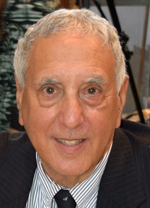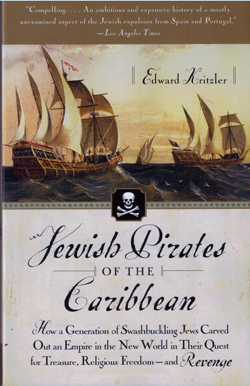Jewish Pirates of the Caribbean by Edward Kritzler, Anchor Books (Random House) (c) 2008, ISBN 9780767-919524; 324 pages including epilogue, chronology, voluminous endnotes and index; $16.95

 SAN DIEGO — You might get the idea from the title of this book that it is about a BBYO Group enjoying a favorite ride at Disneyland. However, it is far more serious than that. It tells about the war Jewish refugees waged against Portugal and Spain and their Grand Inquisitors. It also offers a hint concerning the dispute between Spain and Portugal over the true nationality of 16th century explorer Juan Rodriguez Cabrillo.
SAN DIEGO — You might get the idea from the title of this book that it is about a BBYO Group enjoying a favorite ride at Disneyland. However, it is far more serious than that. It tells about the war Jewish refugees waged against Portugal and Spain and their Grand Inquisitors. It also offers a hint concerning the dispute between Spain and Portugal over the true nationality of 16th century explorer Juan Rodriguez Cabrillo.
Although San Diego Jewish World has reviewed this book before, most notably by contributor Sheila Orysiek, it was made a present to me by John Finley, a family friend, whom I think of as a nephew. So, of course, I read it.
The story goes back to the days of the Spanish Inquisition which commenced approximately the same day in 1492 that Christopher Columbus left Spain on his voyage of discovery. Jews had been ordered out of Spain and some members of Columbus’ crew were secret Jews, who pretended to be Christians publicly, but practiced Judaism privately. Some historians have speculated that Columbus himself might have been a secret Jew, or Converso, although this has never been proven to anyone’s satisfaction. The penalty for converts to Christianity subsequently convicted of “Judaizing” was to be burned at the stake.
One of the first reactions of the Spanish Jews and Conversos to the Edict of Expulsion was to move next door to Portugal, which did not immediately follow Spain’s lead in setting up an Inquisition. “The Portugals” became a code phrase for Jews, either open or closeted. After a short while, however, Portugal also instituted the Inquisition, leaving Jews with few places to live in safety. Their choices were Holland, the Ottoman Empire, or trying to disappear into the the New World “discovered” by Columbus.
The Inquisition went forward in stops and spurts, with monarchs and their representatives sometimes turning blind eyes to Jews and Conversos because of their successes in establishing vast trade networks that helped to fill the coffers of the royals. Meanwhile, the nickname of “the Portugals” for secret Jews came into general usage.
The statue of Juan Rodriguez Cabrillo at the Cabrillo National Monument at the mouth of San Diego Bay was erected by Portuguese in the belief that he had been a native of their country, even though he sailed for Spain. Every year, San Diego’s Portuguese community happily reenacted Cabrillo’s landing in San Diego Bay. However, recently a document signed by Cabrillo was discovered, stating that he was born in Spain. That seemed to settle the dispute.
Author Edward Kritzler unfortunately had died before that document was discovered, but in his book, he anticipated the development. He wrote on Page 39: “Like that of other conversos who obscured their past, Cabrillo’s ancestry is not known. His written reports and navigation skills show him to be an educated man, apparently from a good family. It is probable that Joao Cabrilho [as the Portuguese rendered his name] had Jewish ancestry. Recent scholarship argues he was not Portuguese but Spanish-born, from Cuellar, a city known for its many Jews, who crossed the border to Portugal at the time of the expulsion.”
Some of those Jews and Conversos who sailed on the voyages of discovery remained in Spanish and Portuguese America, where once again they and their descendants were subject to the Inquisition. Having obtained citizenship and religious toleration in Holland, some Jews financed and participated in the Dutch war on Portuguese-claimed Brazil. After capturing the Brazilian port of Recife, they lived openly as Jews. But in 1654, after the Portuguese reconquered Recife, some Jews of that community escaped to the Dutch colony of Curacao in the Caribbean while others went to the Dutch colony of New Amsterdam, where the governor, Peter Stuyvesant, tried to turn them away. However the Jews appealed to the Dutch West India Company, who overturned Stuyvesant and New Amsterdam (later to become New York) had its first permanent Jewish settlers. It’s a matter of some interest that Jews arrived in the future United States of America before George Washington’s ancestors did.
In payment for his services, Christopher Columbus was granted the hereditary ownership of the island of Jamaica to which he and his descendants welcomed Jews and Conversos. Christian landowners and merchants in Jamaica, angered by Jewish mercantile competition, conspired to bring the Catholic Church and its Inquisition to Jamaica, and in the process to overthrow the Columbus family dynasty. Among those who resisted were the Jews who eventually persuaded England to successfully invade the island and grant Jews full rights of citizenship.
As Holland battled Portugal, and England battled Spain, Jewish merchants offered their financing, seamanship, and mercantile skills to the two Protestant countries that challenged the Catholic regimes that had welcomed the Inquisition. Some Jews received commissions as privateers to attack enemy ships in behalf of the two Protestant countries. Others decided to do it on their own, as pirates, attacking the Spanish galleons as they lumbered past Jamaica en route between Spain and the Mexican mainland, which was the storehouse of the silver that was the coin of world trade.
*
Donald H. Harrison is editor of San Diego Jewish World. He may be contacted via donald.harrison@sdjewishworld.com
Hello Mr. Harrison,
Thank you for your article on the “Jewish pirates took revenge on Inquisition’s nations September 12, 2020”. I would like to bring to your attention that since 5-years ago Dr. Wendy Kramer has found more than 25 sixteenth century court documents, showing that Juan Rodriguez Cabrillo is from Palma de Micer Gilio (today Palma del Rio), Cordoba, Spain. If you would like to see some of these documents let me know and I will send you copies or I can meet you at the House of Spain in Balboa Park and give you copies.
Saludos
Jesus Benayas
This letter was received from Lawrence Morrow:
Hello again, Don. It’s been many years since we met. I was always with Tifereth Israel and it was
I there gave a series of lectures on the 11-12th centuries’ medievalist philosopher, physician, poet,
and scholar, Judah Ha-Levi, on whom I wrote a thesis for NYU in 1986. During that period
I resided in Córdoba, España; three years later we purchased our home in Córdoba’s Judería,
or “Jewish Quarter.” My personal history with Córdoba dates from 1975 and I frequently return.
It should be recognized that the birthplace of Juan R. Cabrillo has now definitively been concluded
as in the province of Córdoba in Spain’s Andalucía region. The discovery of critical documentary
evidence some five years ago by Wendy Kramer, Ph.D, has been subject to rigorous peer review
and is now universally considered conclusive. To my knowledge, no credible opposition piece
has been published.
Here is an L.A. Times article from 2015:
https://www.latimes.com/local/california/la-me-cabrillo-birthplace-20150917-story.html
Please let me know if you are interested in learning more on this subject. For now, allow me
to refer your attention to Dr. Kramer’s landmark publication on Cabrillo, cited extensively:
Title Juan Rodríguez Cabrillo: A Voyage of Rediscovery
Author Wendy Kramer
Contributor Maritime Museum of San Diego
Publisher Maritime Museum of San Diego, 2019
ISBN 0944580424, 9780944580424
Length 104 pages
Hello Mr. Harrison,
Thank you for your article… the Maritime Museum published this year [an article] where Dr. Wendy Kramer proves that Juan Rodriguez Cabrillo was born in Palma de Micer Gilio (today Palma del Rio), Cordoba, Spain. If you do not have time to read the whole magazine, please just look at pages 16-17 (Timeline) and Appendix pages 87 through 99 (original court documents of the sixteenth century).
Jesus Benayas
In reply to Messrs. Benayas and Morrow:
Thank you both for providing the information about Wendy Kramer’s research on Juan Rodriguez Cabrillo’s Spanish nationality, which author Kritzler anticipated, although apparently getting the city of his birth wrong. The question that still is unanswered is whether the Spanish-born Cabrillo was in fact a member of a Converso family, forced by the Inquisition to convert from Judaism. In his book, Kritzler suggests that Conversos were winkingly referred to by Spaniards as “Portuguese,” perhaps giving rise to the later confusion among historians about Cabrillo’s true nationality.